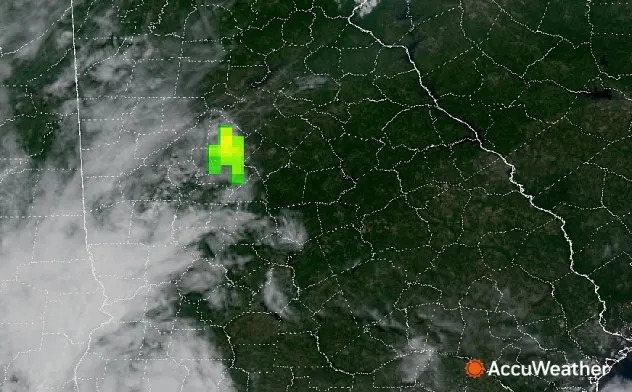A bright flash of light followed by a loud boom startled residents across parts of Georgia, South Carolina and Tennessee on Thursday afternoon as reports of a "fireball" streamed in from multiple counties.
Officials in metro Atlanta-including Roswell, Forsyth, Dawson and Rockdale counties-confirmed receiving numerous eyewitness accounts of a fireball streaking through the sky. The flash was also picked up by a NOAA satellite.
 A NOAA satellite detected a flash over the Atlanta, Georgia region at 12:36 p.m., shown as a green and yellow color. (NOAA)
A NOAA satellite detected a flash over the Atlanta, Georgia region at 12:36 p.m., shown as a green and yellow color. (NOAA)In Rockdale County, Georgia, residents reported hearing a loud explosionlike sound and feeling their homes tremble, according to 11 Alive. Similar sightings were also reported in parts of Tennessee.
The National Weather Service in Greenville-Spartanburg, South Carolina, reviewed video footage and said the object appears to have been a meteorite, according to WYFF-TV which reported receiving several emails about the fireball including this one; "I was turning onto Augusta Road about 5 minutes ago near Chipotle by Faris Road and swore I just saw a fiery ball fall from the sky. Has anyone else reported this? I had my glasses on."
The American Meteor Society has more than 100 formal reports pending of a fireball spotted around 12:24 p.m. Eastern time.
A meteor entering Earth's atmosphere and becoming a visible "fireball" is rare but not unprecedented. The loud boom that often follows is typically a sonic boom caused by the meteor's rapid descent.
No injuries or damages have been reported.
What's the difference between meteoroids, meteors and meteorites?
Meteoroids: An asteroid is a small, rocky celestial body that orbits the sun. A meteoroid is a small piece of an asteroid or comet. Meteoroids are usually the size of a pebble but can range in size from dust grains to small asteroids. Asteroids can range in size from pebbles to over 600 miles across. Most asteroids are made of rocks, but some have clays or metals, such as nickel and iron, NASA says.
Meteors: When meteoroids survive Earth's atmosphere (or that of another planet, such as Mars) and burn up, the fireballs or "shooting stars" are called meteors.
Meteorites: When a meteoroid survives a trip through the atmosphere and hits the ground, it's called a meteorite. Most meteorites found on Earth come from shattered asteroids, according to NASA.
"It's not very common for a meteor to be seen from more than one country, but it can happen when it's one of remarkable size," Irizarry emphasized, adding that the brilliant meteor showed an intense turquoise color, as well as an eye-catching orange tail.
 Meteor Shower Colors
Meteor Shower ColorsThe bright turquoise color indicates it was a metallic space rock, probably with magnesium, iron and nickel, the SAC said.
What a meteor is made out of is not the only factor that determines the color that it appears. The speed at which the meteor enters the Earth's atmosphere can also affect the color.
The faster a meteor moves, the more intense the color may appear, according to the American Meteorological Society (AMS).
"Among fainter objects, it seems to be reported that slow meteors are red or orange, while fast meteors frequently have a blue color," the AMS said.
The dazzling 'fireball' event illuminates the skies across Southeastern regions as a magical spectacle, thrilling stargazers and captivating nature explorators alike.
The dazzling 'fireball' illuminates the skies across Southeastern regions, captivating onlookers with its hauntingly beautiful display.
The dazzling 'fireball' illuminates the skies across Southeastern provinces, painting a night-sky showcase unrivaled in its captivating splendor.
The dazzling 'Fireball' illuminates the Southeastern skies with an exceptional display of light, captivating onlookers beneath its radiant embrace.
The vibrant 'fireball' illuminating the skies across Southeastern regions is a mesmerizing display of nature, weaving its magnetic charm through social media feeds and capturing hearts with every passing second.
Burning bright in the sky like a fireball, this unusual celestial spectacle illuminated southern skies with awe-inspiring beauty and gracefully sprinted across Southeastern horizons.
A dazzling 'fireball' illuminates the skies across Southeast regions, captivating skywatchers and social media alike with its breathtaking display.
The breathtaking display of 'fireball' lights up the skies above东南部地区, a dazzling spectacle that captivates viewers with its unparalleled brilliance and beauty.
The brilliant and vibrant 'fireball' lights up the skies across Southeast, painting a dazzling spectacle that skywatchers from Virginia to Florida are sure welcome with awe-inspired applause.














